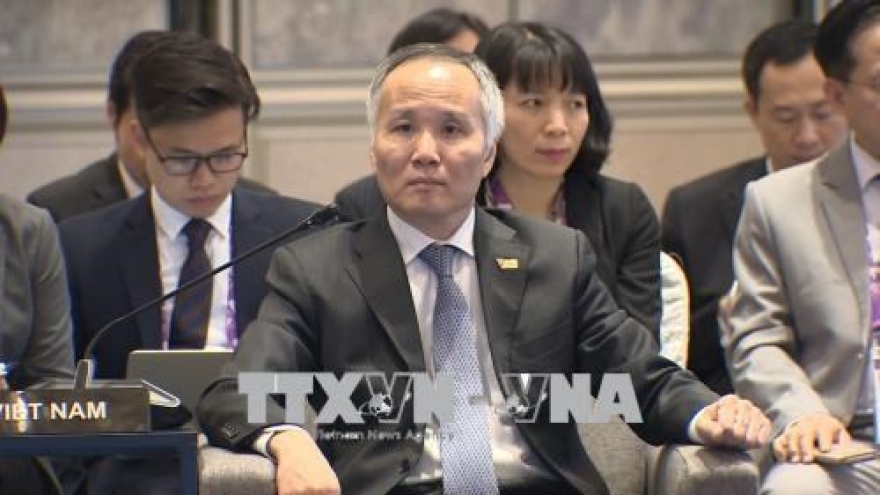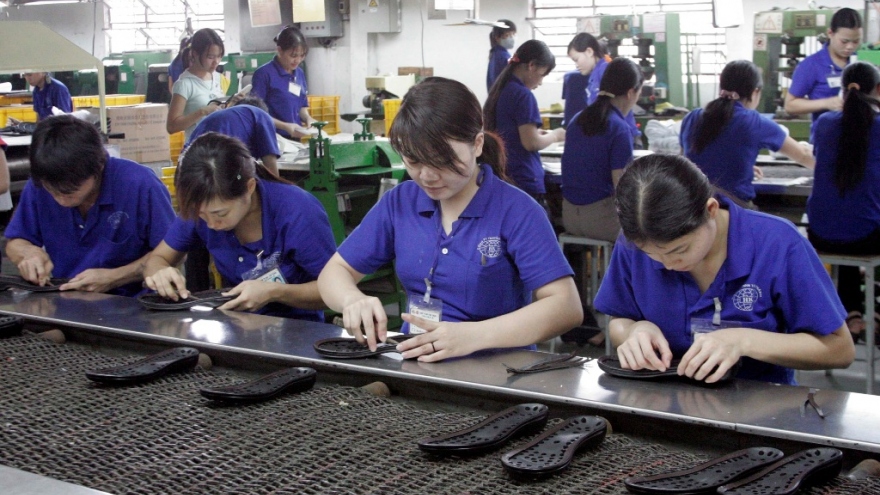AEC broadens its effects on Vietnam
Two and a half years have elapsed since the ASEAN Economic Community was established and businesses in Vietnam are taking advantage of the bloc’s import tariff cuts to expand their exports, aiming to narrow the trade deficit between Vietnam and ASEAN.
 |
Pranoto Soenarto, director of Indonesian coffee company PT Asia Mina Sejahtera, flew from Jakarta to Hanoi last month, with only one goal in mind: seeking Vietnamese partners to cooperate with in its potential coffee projects.
“We’re expanding production, and we need to seek more suppliers of input materials. Vietnam is our best market,” Soenarto said.
PT Asia Mina Sejahtera is among 16 Indonesia coffee firms which recently came to Vietnam for the first time to look for Vietnamese suppliers.
They include big brands like Harro Coffee Group, PT Sabani Internasional, Gebungan Perusahaan Petani Indonesia, and PT Pamora Coffee Indonesia. They met with several Vietnamese firms, including Me Trang Coffee, Minh Tien Coffee, IDD Vietnam, Cuong Anh Import-Export, and Hapro Distribution. A number of deals were agreed on, without details revealed.
According to the Vietnam Coffee-Cocoa Association (Vicofa), Indonesian firms spent over US$33 million importing coffee from Vietnam last year.
It is expected that the figure could reach US$40-45 million this year.
Before 2015, the turnover of Vietnam’s coffee exports to Indonesia was about US$15-20 million a year. “One of the reasons Vietnam is now boosting its coffee exports to ASEAN markets, mostly to Indonesia, Malaysia, the Philippines, Singapore, and Thailand, aside from these nations’ growing coffee demand, is that import tariffs on the product have been reduced to 0%,” said a Vicofa representative.
According to the General Statistics Office of Vietnam (GSO), coffee is just one among many boosted Vietnamese exports to ASEAN since the ASEAN Economic Community (AEC) was established in late 2015. This has also contributed to an overall increase in Vietnam’s exports to ASEAN.
On the rise
The GSO reported that ASEAN is now Vietnam’s fourth-largest export market, after the US, the EU, and China. Vietnam’s export turnover to ASEAN surged from less than US$1 billion in 1995 to US$18.23 billion in 2015.
In 2016, Vietnam’s export turnover to the ASEAN region was US$17.45 billion, down 4.4% on-year.
However, the figure ascended to US$21.7 billion in 2017, up 24.5% on-year. In this year’s first six months, the figure hit US$12.2 billion, up 17.4% on-year.
“Vietnam’s exports to other ASEAN members have risen significantly. Not only foreign enterprises in Vietnam, but also Vietnamese firms have been boosting their exports to ASEAN markets,” said a representative from the Ministry of Industry and Trade (MoIT) at a recent cabinet meeting in Hanoi. “This is thanks to slashed import tariffs, in addition to the business community’s increased awareness about ASEAN markets.”
Key Vietnamese exports to ASEAN include farm produce like coffee, pepper, and cashews, mobile phones, computers, electronics, steel, machinery and equipment, vehicles, textiles and garments, and crude oil.
Nguyen Huu Truong, sales representative of Garmexi Trade JSC, a Vietnamese-Chinese joint venture company in the northern province of Bac Giang, told VIR that if his firm directly exported its garments from China to ASEAN, it would face an average import tax rate of 8-10%, but when the company exports from Vietnam, it enjoys a far lower import tax rate of merely 2-3%, which will be removed completely by the end of this year.
In this year’s first half, Garmexi exported to Malaysia and Singapore, with its turnover increasing by 18-20% on-year. “We are planning to expand our exports to Thailand, Myanmar, the Philippines, and Indonesia in the future,” Truong said.
According to the General Department of Customs, during the first five months of this year, Vietnam earned US$2.2 billion from exporting its goods to Thailand, US$1.66 billion to Malaysia, US$1.33 billion to Singapore, about US$1.6 billion from exports to Indonesia, and US$1.2 billion to the Philippines.
In 2017, Vietnam fetched US$4.7 billion from exporting its goods to Thailand (up nearly 30% on-year), US$4.2 billion to Malaysia (up 31%), about US$3 billion to Singapore (up over 30%), US$2.5 billion to Indonesia, and US$1.1 billion to the Philippines.
Tax slashes for a single market
The AEC is aimed to create a tariff-free zone with 0% tariffs on all traded goods and services, while setting a timetable for removal of non-tariff barriers region-wide.
Nguyen Thi Quynh Nga, vice head of the MoIT’s Multilateral Trade Policy Department, said that the ASEAN-6 nations-the bloc’s most developed economies of Brunei, Indonesia, Malaysia, the Philippines, Singapore, and Thailand-erased 99% of their import tariff lines by 2010. Meanwhile, the remaining nations-Cambodia, Laos, Myanmar, and Vietnam-removed 90% of their import tariff lines in 2015.
“This year, another 7% of tariff lines will be removed by Vietnam,” Nga said.
These numbers mean 669 tariff lines, which will be reduced to 0% by the end of this year for such products as automobiles and their spare parts, steel, motorbikes and bikes and their spare parts, wine, beer, plastics, and paper.
The remaining 3%, on sensitive agricultural items like poultry, eggs, sectioned fruit, rice, processed meat, and sugar, must be reduced to 0% after 2018.
However, in order to benefit from such tariff reductions, goods must meet many conditions. For example, they have to have at least 40% of their materials sourced from within ASEAN.
A bumpy road ahead
Nguyen Ton Quyen, chairman of the Timber and Forest Product Association of Vietnam, said local wood producers find it challenging to enter ASEAN. Despite the AEC tariff cuts, they cannot increase exports to ASEAN due to the low demand for Vietnamese wooden products.
Meanwhile, the firms also import a large volume of materials, such as paints, nails, and chemicals, worth millions of US dollars a year from ASEAN.
“That’s why the whole economy in general is still suffering from a trade deficit with ASEAN,” Quyen said.
The GSO reported that in the first half of this year, while exports to ASEAN reached a turnover of US$12.2 billion, a 17.4% increase, Vietnam’s import turnover from this market was US$15.3 billion, up 11.8% on-year, leaving a trade deficit of US$3.1 billion, marginally lower than the US$3.2 billion recorded in the same period last year.
Last year, the trade deficit was US$6.3 billion, higher than 2016’s US$6.25 billion. Vietnam also has a deficit with Thailand, Malaysia, Singapore, Indonesia, and the Philippines.
Vietnam is also a net importer of many items indispensable for local production from ASEAN, such as petrol, plastics, and components for computers, electronics, machinery, and steel.
However, according to the GSO, Vietnam imports these items for local production and then exports finished products to the world, including ASEAN. Thus, there should be no worry about the trade deficit between Vietnam and ASEAN.
Ibnu Hadi, Indonesian Ambassador to Vietnam, told VIR that in addition to exporting coffee to Indonesia, Vietnam also imports the same product from Indonesia for export-oriented processing.
“While Vietnam is the world’s second-largest coffee exporter and Indonesia is the world’s fourth-largest coffee exporter, and both nations are also ASEAN members and produce 80% of global coffee volume, there is a need for further cooperation between both countries,” he said.
Overall, the two-way trade turnover between Indonesia and Vietnam rose from US$5.58 billion in 2016 to US$6.5 billion last year, including US$3.63 billion worth of Indonesian exports, up 22.51% on-year, and US$2.87 billion worth of Indonesian imports, up 9.37% on-year.


